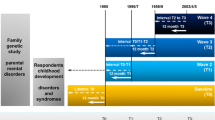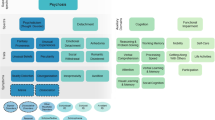Abstract
Because schizophrenia is difficult to treat and exacts large personal and societal costs, there is an effort underway to identify adolescents and young adults at high risk for psychosis. Theory-derived criteria of subthreshold positive symptoms identify a “prodromal” or clinically at-risk population who have conversion rates to psychosis of 40 to 50% within one to two years. However, further characterization of the psychosis prodrome by qualitative research methods could increase the predictive value of the “prodromal” designation. We conducted open-ended interviews with 20 parents of prodromal adolescents that focused on changes observed. The narratives fell into two thematically distinct subgroups, identified as “declining” and “never normal.” The prodromal adolescents described as “declining” had a higher subsequent rate of conversion to psychosis than did the “never normal” group. Although preliminary, these results suggest that a trajectory of change in personality, relationships, and behavior from an essentially normal baseline may be consistent with increased risk for psychosis among prodromal adolescents.
Similar content being viewed by others
References
National Advisory Mental Health Council: Health care reform for Americans with severe mental illness: Report of the National Advisory Mental Health Council. American Journal of Psychiatry 150:1447-1465, 1993.
Solomon P, Draine J: Subjective burden among family members of mentally ill adults: Relation to stress, coping, and adaptation. American Journal of Orthopsychiatry 65(3):419-427, 1995.
Tarrant CJ, Jones PB: Precursors to schizophrenia: do biological markers have specificity? Canadian Journal of Psychiatry 44(4):335-349, 1999.
Jones P, Cannon M: The new epidemiology of schizophrenia. Psychiatric Clinics of North America 21(1):1-25, 1998.
Amminger GP, Pape S, Rock D, et al: Relationship between childhood behavioral disturbance and later schizophrenia in the New York High-Risk Project. American Journal of Psychiatry 156(4):525-530, 1999.
Ott SL, Allen J, Erlenmeyer-Kimling L: The New York High-Risk Project: Observations on the rating of early manifestations of schizophrenia. American Journal of Medical Genetics 105(1):25-27, 2001.
Erlenmeyer-Kimling L: Early neurobehavioral deficits as phenotypic indicators of the schizophrenia genotype and predictors of later psychosis. American Journal of Medical Genetics 105(1):23-24, 2001.
Kendler KS, Gallagher TJ, Abelson JM, et al: Lifetime prevalence, demographic risk factors, and diagnostic validity of nonaffective psychosis as assessed in a US community sample. The National Comorbidity Survey. Archives of General Psychiatry 53(11):1022-1031, 1996.
Parnas J, Cannon TD, Jacobsen B, et al: Lifetime DSM-III-R diagnostic outcomes in the offspring of schizophrenic mothers. Results from the Copenhagen High-Risk Study. Archives of General Psychiatry 50(9):707-714, 1993.
Yung AR, McGorry PD, McFarlane CA, et al: Monitoring and care of young people at incipient risk of psychosis. Schizophrenia Bulletin 22(2):283-303, 1996.
McGorry PD, Yung AR, Phillips LJ: "Closing In": What features predict the onset of first-episode psychosis within an ultra-high-risk group?, in The Early Stages of Schizophrenia. Edited by Zipursky RB, Schulz SC. Washington, DC, American Psychiatric Publishing, 2002.
Miller TJ, McGlashan TH, Rosen JL: Diagnosis and symptom assessment in the schizophrenia prodrome: Psychometrics from the PRIME Research Clinic. Schizophrenia Research 49 (1-2 Supplement):6, 2001.
Davidson L, McGlashan TH: The varied outcomes of schizophrenia. Canadian Journal of Psychiatry 42(1):34-43, 1997.
Edwards J, Maude D, McGorry PD, et al: Prolonged recovery in first-episode psychosis. British Journal of Psychiatry 172(33):107-116, 1998.
Haas GL, Garratt LS, Sweeney JA: Delay to first antipsychotic medication in schizophrenia: Impact on symptomatology and clinical course of illness. Journal of Psychiatric Research 32(3-4):151-159, 1998.
Miller TJ, McGlashan TH, Woods SW, et al: Symptom assessment in schizophrenic prodromal states. Psychiatric Quarterly 70(4):273-287, 1999.
Moller P, Husby R: The initial prodrome in schizophrenia: Searching for naturalistic core dimensions of experience and behavior. Schizophrenia Bulletin 26(1):217-232, 2000.
Olin SS, Mednick SA: Risk factors of psychosis: Identifying vulnerable populations premorbidly. Schizophrenia Bulletin 22(2):223-240, 1996.
Davidson L: Phenomenological research in schizophrenia: From philosophical anthropology to empirical science. Journal of Phenomenological Psychology 25:104-130, 1994.
Wertz FJ: From everyday to psychological description: Analyzing the moments of a qualitative data analysis. Journal of Phenomenological Psychology 14:197-241, 1983.
Giorgi A: Psychology as a human science: A phenomenologically based approach. New York, Harper and Row, 1970.
Kumra S, Jacobsen LK, Lenane M, et al: "Multidimensionally impaired disorder":Is it a variant of very early-onset schizophrenia? Journal of the American Academy of Child and Adolescent Psychiatry 37(1):91-99, 1998.
Phillips LJ, Velakoulis D, Pantelis C, et al: Non-reduction in hippocampal volume is associated with higher risk of psychosis. Schizophr Research 58(2-3):145-158, 2002.
Author information
Authors and Affiliations
Corresponding author
Rights and permissions
About this article
Cite this article
Corcoran, C., Davidson, L., Sills-Shahar, R. et al. A Qualitative Research Study of the Evolution of Symptoms in Individuals Identified as Prodromal to Psychosis. Psychiatr Q 74, 313–332 (2003). https://doi.org/10.1023/A:1026083309607
Issue Date:
DOI: https://doi.org/10.1023/A:1026083309607




